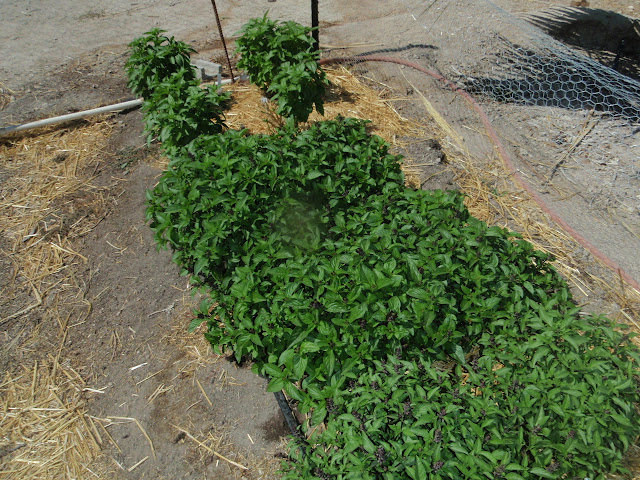Q. My garden area is about 40 feet long x 40 feet wide. The soil is native. How much compost do I need?
.JPG) |
| You will need at least a truckload, that's 2 cubic yards. Continue to add compost as it needs it, probably every one to two years. |
A.
If this is a light tan native soil, you will need between about 1 inch of
compost, during its first year, laid on the top of this native soil and
rototilled to a depth of 8 to 12 inches. You would need to order about 3 cubic
yards of compost to accomplish this. If you are ordering by weight this amount
of compost totals about 4500 pounds, but its weight depends on its degree of
wetness. A standard pickup truck will carry about 2 cubic yards, dry, to give
you an idea. In the following years one pickup load every one or two years will
be plenty to boost production.
 |
| Basil is growing with a rich compost and no extra fertilizer is needed. Straw is used as a mulch to conserve water and keep the soil cool. Native desert soil is used an enriched with compost. |
Depending on how “rich” the compost is, a
small bag of starter fertilizer high in phosphorus (the middle number) may or
may not be needed by rototilling, or soil mixing with a shovel, compost to that
depth.
 |
| These are very large plots growing eggplant in compost amended native desert soil with drip irrigation. These raised beds are without sidewalls, just the natural slope of the soil keeps it together. |
After the compost has been rototilled and water
applied to this amended soil, the soil will become darker brown in color.
Approximately one pickup load will need to be added to this area every year, or
every other year, depending upon the garden soil texture and color. During the first
season of growth, the amended native soil will be productive. It will take
about three seasons of growth and watering before the soil is highly productive,
each season getting better.
Don’t walk on this soil except for
planting and harvesting. Instead, created walkways between growing areas should
be shoveled about 18 – 24 inches wide and the garden soil leveled. No sidewalls
need to be constructed in this set up.
No comments:
Post a Comment